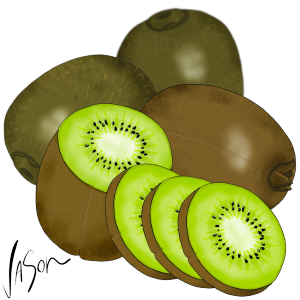June 30, 2014
 by Jason Ford
by Jason Ford
Ford on Food
Kiwifruit may be commonplace nowadays; however when I first started cooking in the mid 1980s, it was still considered by many people as an exotic fruit.
Kiwifruit has a long and interesting history.
It was originally referred to as ‘Chinese Gooseberry’ or Yang Tao in its native country of northern China. There are also many variant species originating from other Asian countries.
It wasn’t until New Zealand began cultivating and exporting the fruit to countries such as the US that it became popular in Western cultures.
It also underwent a market driven re-branding after World War II, to the well-known name of ‘Kiwifruit’, which helped attract Western consumers.
Kiwifruit has a light brown, furry skin that encases a soft, bright green flesh. The centre contains an edible white core surrounded by dozens of tiny black seeds.
Although the skin is edible, most people either peel the fruit or cut it in half and scoop the flesh out with a spoon.
The flavour of a ripe kiwifruit would be best described as sweet and perfumed, yet slightly acidic.
Kiwifruit flesh is best served raw as an addition to fruit salad, blended into smoothies or pureed and frozen as a sorbet.
It is high in vitamin C, and has a unique enzyme that can help tenderize other ingredients such as squid flesh.
I have tenderized calamari rings in fresh kiwifruit puree on many occasions, it works a treat.
* * *
Mean Green Smoothie
I’m pretty much addicted to fruit and vegetable smoothies these days, and one of my favourites contains kiwifruit.
Blend together the following chilled ingredients:
- 2 kiwifruits, peeled and chopped
- 1 green apple, cored and chopped
- 2 cups fresh baby spinach leaves
- 2 tbsps Greek yoghurt
- ½ cup almond milk
- 1 tbsp honey























